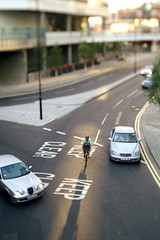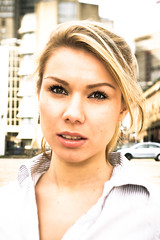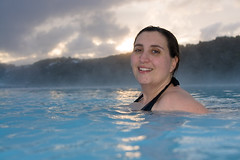 Some time ago, I got myself a tilt and shift lens for my Minolta, because I was interested in expermenting with camera movements, but didn't want to buy a view camere. I was interested in things like the Scheimpflug Principle which allows you to extend the dof of field parallel to the ground and the opposite effect where you restrict the plane of focus to a small slice of the image. I used the lens to take a number of images, that made cars look like toys and it was good fun for a while, but eventually I stopped using it.
Some time ago, I got myself a tilt and shift lens for my Minolta, because I was interested in expermenting with camera movements, but didn't want to buy a view camere. I was interested in things like the Scheimpflug Principle which allows you to extend the dof of field parallel to the ground and the opposite effect where you restrict the plane of focus to a small slice of the image. I used the lens to take a number of images, that made cars look like toys and it was good fun for a while, but eventually I stopped using it.
Fast forward to today and after reading "Lighting for Portrait Photography" , I was inspired by the images of Tobias Titz to get the T&S lens out and use it for portraits. In Tobias's white bodies series, he used the camera movements to throw everything out of focus except for the heads, a white background and cross processing make the body blend into the background.
 I was fortunate to be assisting flickr member quochuy on a shoot near London Bridge, and he allowed me to take a few shots myself. It was just after midday and the sun was high and left, illuminating the buildings in the background. I got Huy to hold up a silver umbrella for me to put the model in the shade and I used a flash gun in a white shoot-through umbrella behind me over my left shoulder to fill with controlled light. The lens aperture was set between f2.8 and f4 and I used the maximum amount of tilt on the lens to focus just on the eyes. I deliberately overexposed, so as to keep the contrast between the model and the background low.
I was fortunate to be assisting flickr member quochuy on a shoot near London Bridge, and he allowed me to take a few shots myself. It was just after midday and the sun was high and left, illuminating the buildings in the background. I got Huy to hold up a silver umbrella for me to put the model in the shade and I used a flash gun in a white shoot-through umbrella behind me over my left shoulder to fill with controlled light. The lens aperture was set between f2.8 and f4 and I used the maximum amount of tilt on the lens to focus just on the eyes. I deliberately overexposed, so as to keep the contrast between the model and the background low.
I did miss a trick, because the tilted plane of focus was running from the eyes down to the ground. This meant that sometimes background objects I didn't want in focus snuck into the pictures. I should have tilted it from the eyes to the sky and then it would have been less noticable.
I processed the images in lightroom and fiddled about with split-toning to give the images a cross processed look. I'm pretty pleased with the results, the eyes positively pop, though I would say that I need to refine the technique a little. You can see more images on my flickr page







